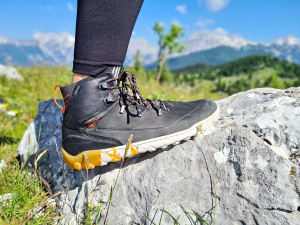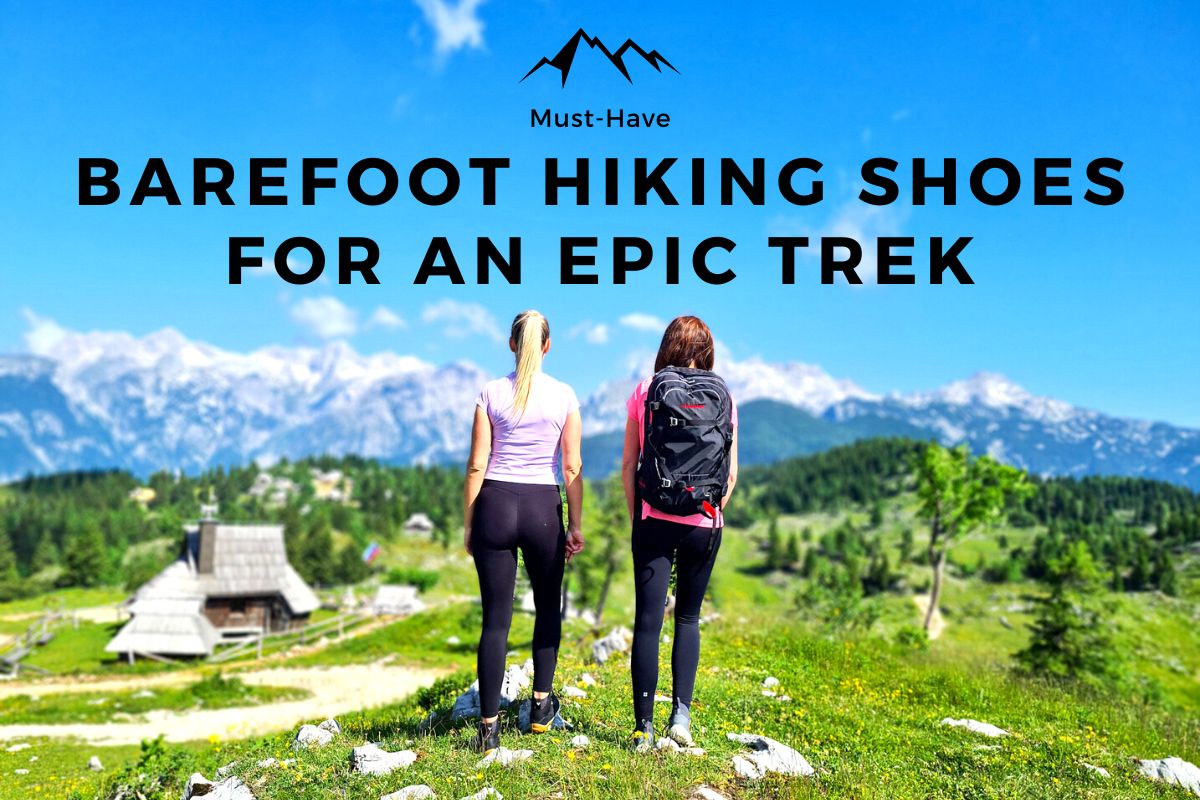Welcome to our comprehensive guide on the best barefoot and minimalist hiking shoes for adults and kids. If you’re a hiking enthusiast or have just recently discovered the joys of hiking, you may have come across the terms “foot-shaped,” “zero drop,” “flexible,” and “wide toe box.” You might be wondering, are barefoot shoes good for hiking?
In this blog post, we will dive deep into the world of barefoot shoes specifically designed for hiking and explore their benefits, including improved natural movement, enhanced stability, and increased sensory feedback from the terrain.
Check out our ‘Must-Have Barefoot Hiking Shoes for an Epic Trek‘ in our separate post.
The Benefits of Hiking in Barefoot Shoes: Freeing Your Ankles and So Much More
When it comes to hiking, many people believe that supportive, protective hiking boots are the way to go. However, conventional hiking boots can feel heavy and restrictive, constraining your ankle and foot movement.
This reinforced ankle and squished toes prevent the whole foot from functioning properly, and often leading to strain and discomfort in other parts of your body like knees, hips, and back.
Here are some of the key benefits of hiking in barefoot shoes:
Free Your Ankles for Greater Mobility
Barefoot and minimalist hiking boots and shoes allow your ankles to move freely, enabling your body to react more effectively and engage the relevant muscles when you encounter slippery terrain.

Feel Light as a Feather
Barefoot hiking shoes are much lighter in weight, providing the sensation of almost wearing nothing at all.
Unlike the fatigue caused by the heaviness of conventional hiking boots that can tire out your legs more quickly, barefoot trekking allows your feet and legs to feel light and lively.
Heighten Your Sensory Awareness
The thin and flexible sole of barefoot shoes increases your awareness of the ground beneath you by allowing you to feel the trail. In fact, about 80% of the information our brains collect about balance comes from the soles of our feet.

With a heightened sense of awareness, our ankles are less likely to sprain, and the point of gravity is closer to the ground.
Happy Toes, Happy Hiking
Barefoot hiking boots have a wide toe box that respects the natural shape of the human foot, allowing your toes to properly splay, providing a larger surface area for balance and a proper foot movement.

Are Barefoot Shoes Good for Hiking?
Many people are concerned about whether barefoot shoes are good for hiking and if they are safe to use. It is important to be mindful of safety regulations to ensure that you don’t risk injury.
Barefoot shoes can be awesome for hiking, but there are a few things to keep in mind. If you’ve been wearing regular shoes for a long time, your foot muscles might need a bit of time to get used to the change.
Regular shoes have provided support to the foot structures for several years and make them weak in some ways. Barefoot shoes work by letting our foot muscles do their thing, so we need to give those muscles time to get strong again.
If you’re new to barefoot shoes, it’s a good idea to start slow. Take it easy by walking on easier trails before you hit the tough ones. This helps your foot muscles get stronger gradually.

Barefoot hiking shoes are pretty light, so you can carry them easily. You might want to switch between regular hiking shoes and barefoot ones, depending on where you’re hiking. For instance, use regular hiking shoes on rocky paths and switch to barefoot ones on smoother trails, especially if you’re new to this.
Remember, it’s important to listen to your body. If you take your time and pay attention to how your feet feel, you can enjoy the benefits of barefoot hiking without any worries.
Barefoot Hiking Boots vs. Barefoot Hiking Shoes: Which One to Choose?
Choosing between barefoot hiking boots and barefoot hiking shoes can be a tough decision. Do you really need boots, or can you just go with shoes?

Even though barefoot shoes are designed to be super lightweight, barefoot hiking boots are surprisingly light too. They’re made from softer materials compared to regular hiking boots. But, there are some things to think about when it comes to hiking in barefoot shoes instead of barefoot boots:
- They’re easy to pack (and that means not a lot extra weight!)
- They’re quicker to put on
- Your ankles are totally free
But, here’s the thing: even though barefoot hiking boots cover your ankle, they’re made from softer materials that allow your ankle to move. Still, some models might feel a bit more restrictive than others. Some use really cool designs to make sure your ankle moves freely. Plus, the way you lace them up can also affect how your ankle moves. Check out our list of the ‘Must-Have Barefoot Hiking Shoes for an Epic Trek‘ to find the top options out there!
So, when should you go for barefoot hiking boots instead of shoes?
- If you need extra protection on rough terrain, like rocky slopes.
- When you want a bit more warmth, especially in colder conditions.
Do Sole Thickness and Tread Matter?
When it comes to barefoot and minimalist hiking boots and shoes, their common features are foot-shaped design, wide toe box, zero-drop sole, and no arch support. However, they can differ in sole thickness and cushioning.

Barefoot hiking shoes and boots often come with deeper lugs for better traction on various surfaces. This typically provides slightly more cushioning compared to barefoot shoes meant for daily wear.

Yet, it’s important to note that grip isn’t solely about lug thickness. Adhesion and the foot’s ability to grip and balance matter too. Thicker, less flexible soles may lack this aspect.

In our list of ‘Must-Have Barefoot Hiking Shoes for an Epic Trek,’ we’ve featured barefoot shoes with some of the thinnest and most flexible soles. However, we’ve also included options with slightly thicker, zero-drop soles. This caters to those who desire the benefits of a zero-drop sole and a wide toe box for maximum toe freedom but aren’t quite prepared to try the thinnest soles just yet.
Tips for Finding the Right Size in Barefoot Hiking Shoes
When choosing your perfect size in barefoot hiking shoes and boots always consired all circumstances that influence on the amount of space inside the shoes.
- Season: If you intend to hike during the warmer months, you would typically opt for thinner socks or remove the insoles that provide warmth on colder days. This allows more space, enabling your toes to move comfortably.
- Socks Selection: While some barefoot hiking shoes work well without socks, many prefer the added comfort of socks during hikes. Opt for socks with a wide toe box or even toe socks. These options allow your toes to spread naturally inside the shoe.
- Extra Insoles: Depending on the season and your preference, you might consider extra insoles for added warmth or cushioning. If you decide to use insoles, make sure that there is enough room for the toes to spread apart, despite the extra insole.

All these elements play a role in determining the size and model that suits you. Strive for a minimum of 12 mm of space inside the boots. Test the fit with socks and insoles if you intend to wear them together. Remember, after extended hikes, feet can swell, and downhill walks might cause your foot to shift forward slightly, necessitating more than 12 mm of space.

Lastly, pay attention to width. Can your toes spread comfortably within the shoe? Consider how the fit feels with socks, toe socks, or with an extra insole. This comprehensive approach ensures a comfortable and well-fitting pair of barefoot hiking shoes.
What are The Best Barefoot & Minimalist Hiking Shoes and Boots Out There?
After extensive testing of various barefoot hiking shoes and boots throughout the past years, we’ve curated our top selections for both men and women. We’ve also included options for kids in our dedicated blog post titled ‘Must-Have Barefoot Hiking Shoes for an Epic Trek‘.
Final Thoughts
To wrap up, the answer to “Are barefoot shoes good for hiking?” is a yes, as they offer a multitude of benefits, amplifying balance, posture, and sensory feedback. However, keep in mind that nailing the right size, sole thickness, and understanding your foot’s readiness for demanding trails are pivotal. As you embark on your inaugural barefoot hiking experience, remember to take it easy, listen to your feet, and gradually progress. This journey is about connection and comfort, step by step.




